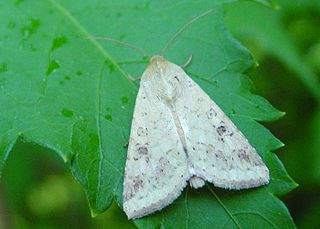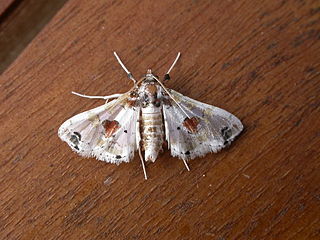
Black sigatoka is a leaf-spot disease of banana plants caused by the ascomycete fungus Mycosphaerella fijiensis (Morelet), also known as black leaf streak. It was discovered in 1963 and named for its similarities with yellow Sigatoka, which is caused by Mycosphaerella musicola (Mulder), which was itself named after the Sigatoka Valley in Fiji. In the same valley an outbreak of this disease reached epidemic proportions from 1912 to 1923.

Helicoverpa armigera is a species of Lepidoptera in the family Noctuidae. It is known as the cotton bollworm, corn earworm, Old World (African) bollworm, or scarce bordered straw. The larvae feed on a wide range of plants, including many important cultivated crops. It is a major pest in cotton and one of the most polyphagous and cosmopolitan pest species. It should not be confused with the similarly named larva of the related species Helicoverpa zea.

Cochliobolus miyabeanus is a fungus that causes brown spot disease in rice.
Mycosphaerella berkeleyi is a fungal plant pathogen. It is the causal agent of the peanut foliar disease Late Leaf Spot.
Mycosphaerella cruenta, also called Pseudocercosopora cruenta in its asexual stage, is a fungal plant pathogen belonging to the group Ascomycota. It can affect several legume plants, including species of Phaseolus, Vigna, Calopogonium, Lablab niger, Mucuna and Stizolobium deeringianum [Mucuna pruriens][2]. It causes cowpea cercospora leaf spot, one of the most widespread and significant plant diseases in Africa and Asia. A city in China reported a 100% Mycosphaerella cruenta infection rate on cowpea in 2014[5]. In Africa, an epidemic can cause a yield loss of up to 40% [3].
Sphaerulina oryzina is a fungal plant pathogen infecting rice. Propiconazole is an effective fungicide recommended for use in rice culture.

Sarocladium oryzae (Sawada) is a plant pathogen causing the Sheath rot disease of rice and Bamboo blight of Bambusoideae spp. in Asia.

Colletotrichum orbiculare is a plant pathogen of melons and cucumber. It causes the disease anthracnose that can effect curcubits causing lesions on various parts of the plant. It can effect cucumbers, melon, squash, watermelon and pumpkin, especially when the weather is rainy, humid and warm. It can be transmitted by seed as well as soil and survive between crops. It is also spread by feeding cucumber beetles, splashing water, tools and workers. Efforts to control the fungus include the practice of rotating cucurbits out for a 2-year period, planting cultivars with resistance, burning infected crops and careful control of weeds. Chemical control measures are also available.
Colletotrichum truncatum is a fungal species and plant pathogen on soybeans.

Colletotrichum sublineola is a plant pathogen that causes anthracnose in wild rice and sorghum

Septoria malagutii is a fungal plant pathogen infecting potatoes. The casual fungal pathogen is a deuteromycete and therefore has no true sexual stage. As a result, Septoria produces pycnidia, an asexual flask shaped fruiting body, on the leaves of potato and other tuber-bearing spp. causing small black to brown necrotic lesions ranging in size from 1-5mm. The necrotic lesions can fuse together forming large necrotic areas susceptible to leaf drop, early senescence, dieback, and dwarfing. Septoria malagutii has been found only in the Andean countries of Bolivia, Ecuador, Peru, and Venezuela at altitudes of near 3000 meters. Consequently, the fungi grows and disperses best under relatively low temperatures with high humidities, with optimal growth occurring at 20 °C (68 °F). The disease has caused devastation on potato yields in South America and in areas where this disease is common, potato yields have been seen to drop by 60%.

Colletotrichum musae is a plant pathogen primarily affecting the genus Musa, which includes bananas and plantains. It is best known as a cause of anthracnose indicating ripeness on bananas.

Cassava mosaic virus is the common name used to refer to any of eleven different species of plant pathogenic virus in the genus Begomovirus. African cassava mosaic virus (ACMV), East African cassava mosaic virus (EACMV), and South African cassava mosaic virus (SACMV) are distinct species of circular single-stranded DNA viruses which are transmitted by whiteflies and primarily infect cassava plants; these have thus far only been reported from Africa. Related species of viruses are found in India and neighbouring islands, though cassava is cultivated in Latin America as well as Southeast Asia. Nine species of cassava-infecting geminiviruses have been identified between Africa and India based on genomic sequencing and phylogenetic analysis. This number is likely to grow due to a high rate of natural transformation associated with CMV.
Tobacco necrosis virus A (TNV) is a plant pathogenic virus of the family Tombusviridae.
Rice yellow mottle virus (RYMV) is a plant pathogenic virus, belonging to the genus Sobemovirus. The genome is a positive-sense single strand RNA of 4450 nucleotides in length and is not polyadenylated. It was first reported in Kenya in 1966 in one of Africa's first cultivation intensification schemes, due to RYMV's association with intensification, but DNA analysis of its evolutionary history shows it to have evolved in East Africa in the 19th century. Since its identification in Kenya it has been detected in many countries in sub-Saharan Africa. It has also been detected in Central Africa, but has yet to be seen outside the continent. The genomic organization of RYMV is most similar to that of Cocksfoot mottle sobemovirus. RYMV is one of the better-studied plant-virus pathosystems.

Leucinodes orbonalis, the eggplant fruit and shoot borer or brinjal fruit and shoot borer, is a moth species in the genus Leucinodes described by Achille Guenée in 1854. Its native distribution is in the tropical and subtropical parts of Australia and Asia, where it is recorded from Pakistan, Nepal, India, including the Andaman Islands, Sri Lanka, Bangladesh, Myanmar, Laos, Cambodia, Vietnam, Thailand, China, Taiwan, Japan, Malaysia, Singapore, Brunei, the Philippines, and Indonesia (Java). It has also been intercepted from fruit imports in the U.S.A., the Netherlands, Denmark and Great Britain, where it was also reported from the wild. A taxonomic revision of the Leucinodes species of Sub-Saharan Africa concluded that L. orbonalis is currently not present in Africa, and that previous records of this species were misidentifications of previously undescribed species.

Busseola fusca is a species of moth that is also known as the maize stalk borer. It is known from Ethiopia.

Grey leaf spot (GLS) is a foliar fungal disease that affects maize, also known as corn. GLS is considered one of the most significant yield-limiting diseases of corn worldwide. There are two fungal pathogens that cause GLS: Cercospora zeae-maydis and Cercospora zeina. Symptoms seen on corn include leaf lesions, discoloration (chlorosis), and foliar blight. Distinct symptoms of GLS are rectangular, brown to gray necrotic lesions that run parallel to the leaf, spanning the spaces between the secondary leaf veins. The fungus survives in the debris of topsoil and infects healthy crops via asexual spores called conidia. Environmental conditions that best suit infection and growth include moist, humid, and warm climates. Poor airflow, low sunlight, overcrowding, improper soil nutrient and irrigation management, and poor soil drainage can all contribute to the propagation of the disease. Management techniques include crop resistance, crop rotation, residue management, use of fungicides, and weed control. The purpose of disease management is to prevent the amount of secondary disease cycles as well as to protect leaf area from damage prior to grain formation. Corn grey leaf spot is an important disease of corn production in the United States, economically significant throughout the Midwest and Mid-Atlantic regions. However, it is also prevalent in Africa, Central America, China, Europe, India, Mexico, the Philippines, northern South America, and Southeast Asia. The teleomorph of Cercospora zeae-maydis is assumed to be Mycosphaerella sp.

Prostephanus truncatus is commonly referred to as larger grain borer (LGB) with reference to the related Rhyzopertha dominica, which is relatively smaller, and referred to as the lesser grain borer. P. truncatus is about 6 mm (0.24 in) long as compared to 3 mm (0.12 in) long in R. dominica. At optimum conditions of 80% relative humidity and 32 °C (90 °F), and available food, P. truncatus completes its lifecycle within 27 days. It is a serious pest of dried grains, especially maize and dried cassava in West Africa. This beetle is believed to have been introduced into West Africa through food aid from America. It reached Africa through Tanzania in the early 1970s.
Maize lethal necrosis disease is a viral disease affecting maize (corn) predominantly in East Africa, Southeast Asia and South America, which was recognised in 2010. It is caused by simultaneous infection with two viruses, MCMoV and any of several Potyviridae.












